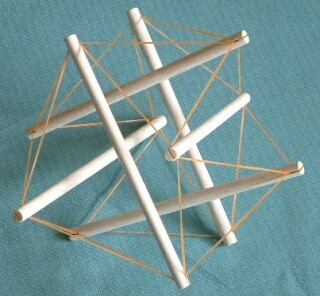 by Flemming Funch by Flemming Funch
From Kuro5hin article Tensegrity is a term used in architecture.
What is tensegrity?
“The word ‘tensegrity’ is an invention: a contraction of ‘tensional integrity’. Tensegrity describes a structural-relationship principle in which structural shape is guaranteed by the finitely closed, comprehensively continuous, tensional behaviors of the system and not by the discontinuous and exclusively local compressional member behaviors. Tensegrity provides the ability to yield increasingly without ultimately breaking or coming asunder”
Richard Buckminster Fuller (excerpt from Synergetics, p. 372.)
The tension of the different parts of the structure gives the structure its strength. Separately each part is a burden on the structure. Together the parts make the structure strong.
Tensegrity structures are distinguished by the way forces are distributed within them. The members of a tensegrity structure are either always in tension or always in compression.
The United States has a similar tensegrity. Yeah, hm, I guess. But not nearly as well as it used to, or as well as it could. And not as much at this particular time. However, the author does a nice job of outlining how different elements in society sort of push against each other, to create a more stable system overall.
But you spoil the tensegrity if you put too many things in one hat, or make things too one sided. There needs to be a certain equilibrium.
|
|
 by Flemming Funch
by Flemming Funch